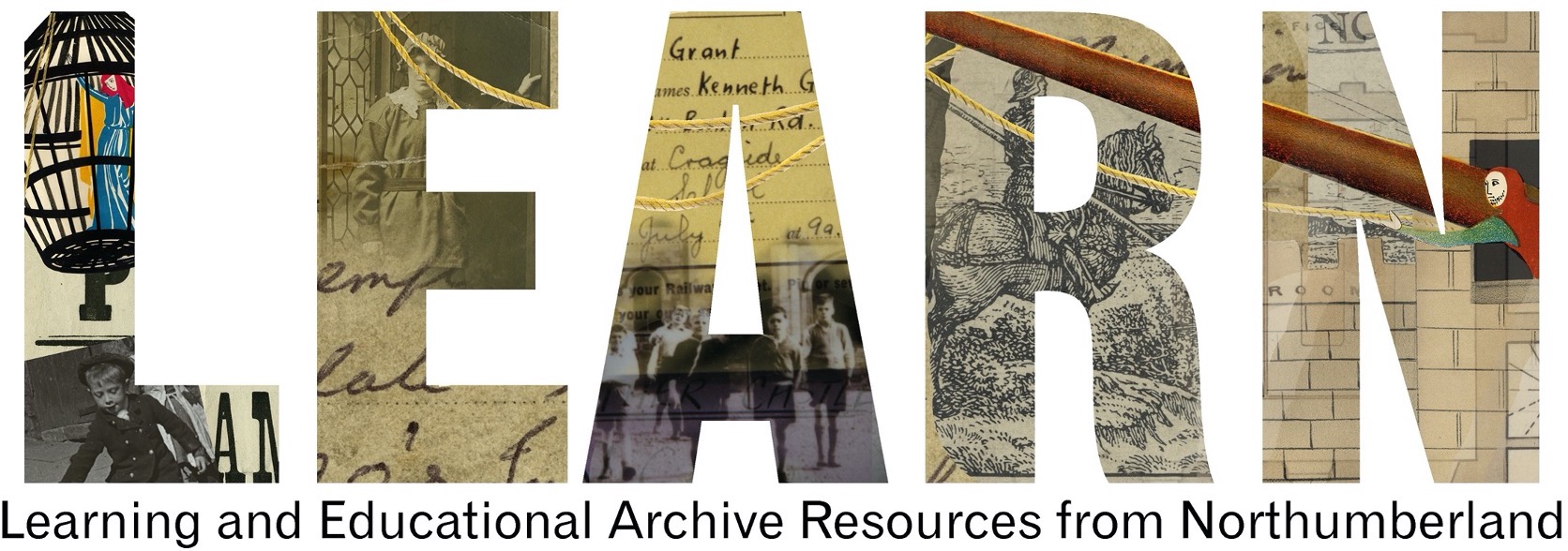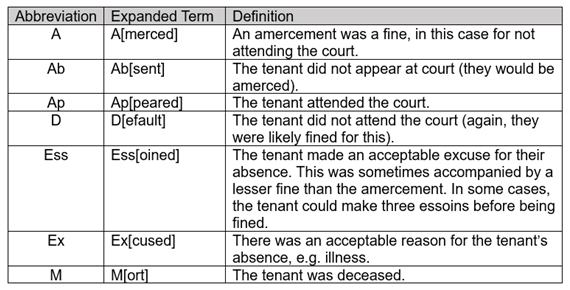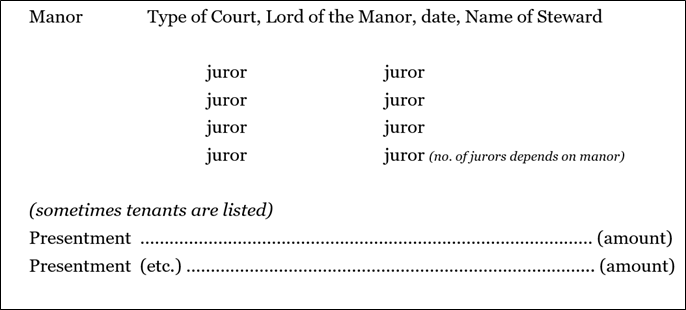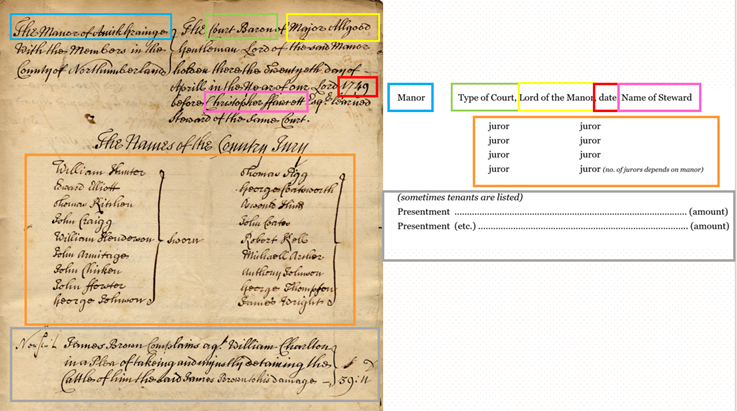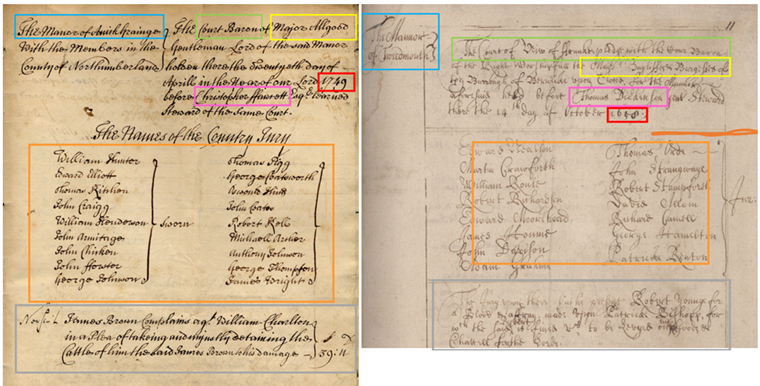Everyday Life in a Northumbrian Manor
All Manor of Things: An introduction to manors and their documents
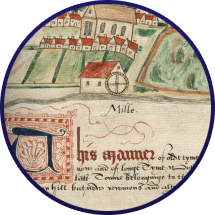
Manorial Documents
Manorial documents consist of records which have been produced by manorial courts. Manor courts deal with the rules and customs of the manor, admittance of new tenants, land use and general business, which can all tell us a lot about daily life in the manor.
What are the manorial courts?
There are two main types of manorial court: The court leet with view of frankpledge and the court baron.
Court Leet with View of Frankpledge
The court leet usually dealt with the more serious issues within the manor. There was a focus on law and order, so you often see “blood and affray” (assault), or debt and trespass offences appear at these courts. Alongside these, constables were usually appointed at this court. Duties which are devolved from a higher court may also appear at the court leet including the ‘assize of bread and ale’, which involved ensuring the correct measurements in each.
The ‘view of frankpledge’ was a system whereby there was a mutual agreement to uphold the law and order in the manor. You sometimes see the court leet referred to as just the “court of view of frankpledge”, so it is worth remembering this phrase.
Court Baron
The court baron dealt with the manorial customs, and any offences against the manor rules. Minor crimes and the appointing of manor officials were also dealt with at this court. Think of this court as dealing with the more localised issues relating to the manor, such as keeping the manor tidy, regulating farming and crops, and ensuring livestock remain in their pinfolds. The surrender and admission to copyhold land also took place at this court (this will be explained in more detail below).
The frequency of both the court leet and court baron was decided by the manorial customs and so it can vary. Usually the court leet would be held once or twice a year, and the court baron monthly. It is also worth noting that sometimes the court leet and the court baron can appear on the same court roll.
What types of documents can you expect?
There are several types of documents which were created by the manorial courts. Here we will focus on some of the more common manorial documents found in Northumberland Archives’ collections.
Court Rolls/Court Books
Court rolls are the most common document in our collections. These detail the court proceedings, and usually include:
- The name of the manor
- The name of the lord/lady of the manor
- The name of the steward
- The date
- A list of jurors
- The presentments – meaning the issues brought before the court.
They are called court rolls because they were often written on a rolled piece of paper or parchment.
You can also find court books, which in our collections include the same information as the court rolls, just written in a large volume.
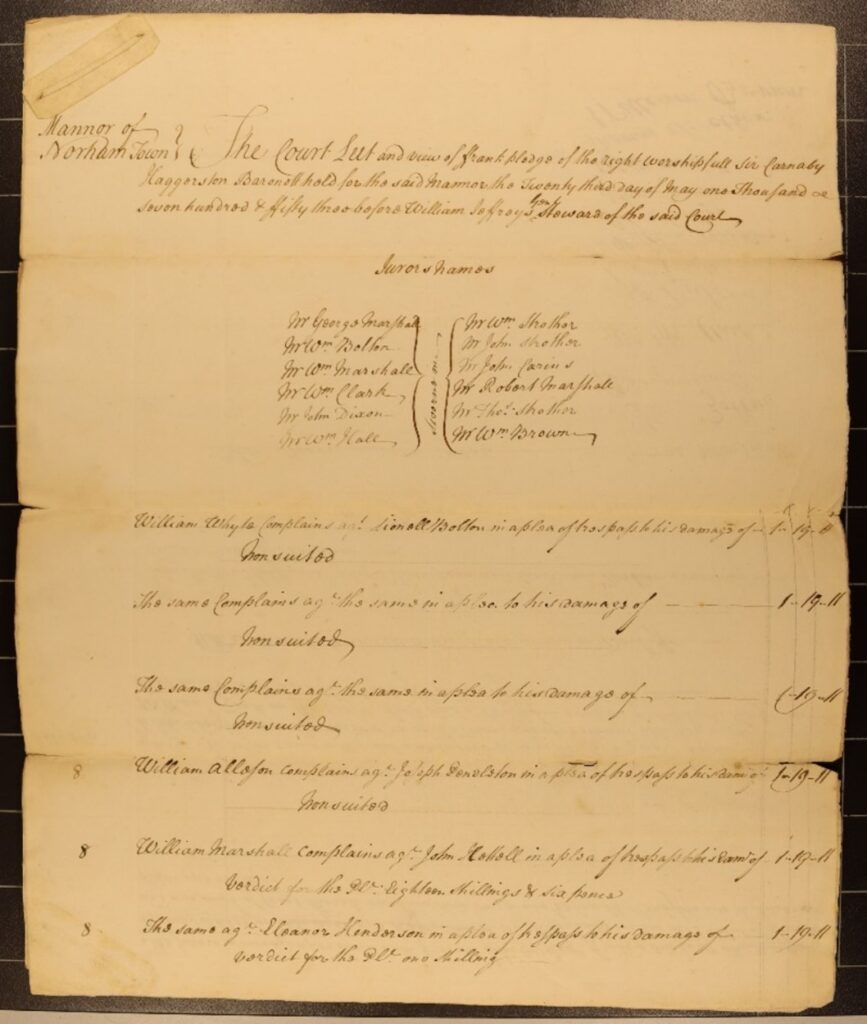
Call Rolls/Suit Rolls
The terms “call roll” and “suit roll” are both used for the list of tenants required to attend the manorial courts. ‘Call roll’ means those “called” to court, and “suit roll” referred to those who “owed suit” to the manor. As with the court rolls, call rolls are sometimes written into a register, called a call/suit book or can be an individual list.
A modern researcher can use the rolls to see the names of all those living in a manor at a given time. The rolls both include the names of the tenants required to attend the court, and a note as to whether they attended. This can be a bit of a challenge to work out, as the scribes tend to abbreviate the words denoting attendance. Some common examples of those are included below:
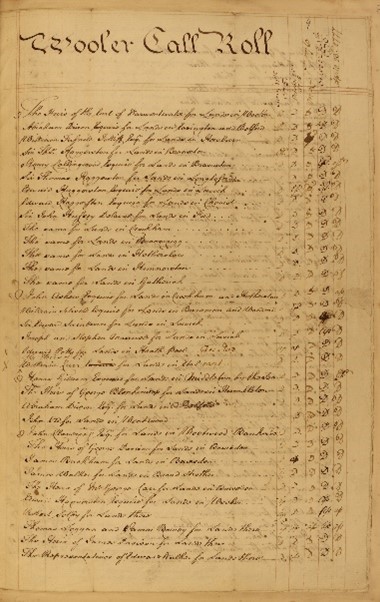
Surrenders and Admittances
These documents include the surrender of copyhold land by a tenant, and the admittance (or admission) of a new tenant to that land. This process had to go through the court baron, regardless of whether the property was passing to an heir or a completely new tenant. For example, if you can find a collection of these records for a manor in which you knew your ancestor lived, you may be able to see exactly what properties they owned over time.
The documents will include:
- The name of the individual(s) coming to court to surrender their land.
- The land in question: This would usually be the name of a property, e.g. “Moss Farm”, or the name of the land owner again, e.g. “Mr Bloggs’ land”. It was usually distinguished by the names of the surrounding properties. For example, ‘the property is bordered on the east by Mill Farm, and on the west by the land of Mr Smith, etc.” The challenge here can sometimes be working out exactly what was included in the property.
- The size of the land: This is usually given in acres, roods and perches – see the later section on measurements.
- The name of the individual(s) who will be admitted as the new tenants.
- Any fines or costs.
In our collection we have both the surrender and admittance documents for many manors, and in some cases, such as Hexham manor, we have a collection of “intents to surrender” land, which detail the same information, but were written prior to the court, stating when they intend to make their surrender of land.
You may find a surrender and admission as individual documents, or in many cases these are included in a court roll, as part of the presentments.
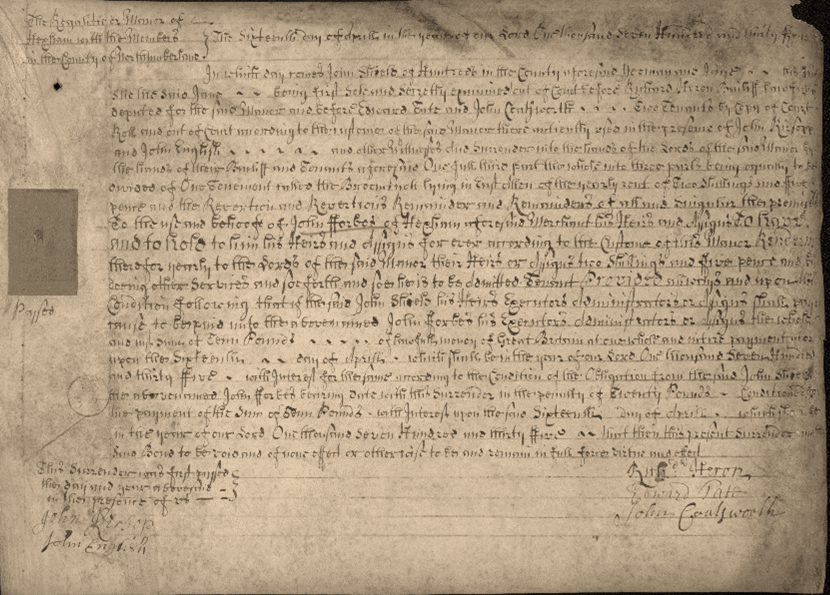
Some other document types:
We do also have several other types of manorial document in our collection, however, we will focus on the above documents in this resource. Other types of records available include:
- Accounts – Accounts written by the reeve or bailiff of the manor, relating to the expenditure and income of the manor.
- Enfranchisements – This is the process of a lord/lady of the manor converting copyhold land into freehold land. The process produced many documents, but the most important were deeds of enfranchisement. These became more common following the Copyhold Act of 1852, which included a clause allowing tenants to demand enfranchisement on their land. This process would extinguish the copyhold ruling on the land, which is why they’re sometimes called “extinguishments”.
- Maps/Plans – Maps of a manor can survive, but these are very rare, certainly in our collection. You may find a map or plan of part of a manor, but often these were created in response to a dispute, so will only cover the area in question. Again these are not common.
- Perambulation – Sometimes called a “perambulation of the bounds”. This is a written account of the boundaries of the manor, established by members of the court walking around the boundaries. These were sometimes completed in response to a boundary dispute, but can also be completed routinely or as annual events.
- Rentals – These list the tenants and the rent that they were due to pay.
- Steward’s Papers – Administrative documents gathered by the steward to support the running of the manor courts. These can include correspondence, the steward’s notes and copies of earlier rolls.
- Surveys – Detail the land in the manor and the customs relating to that land.
- Terriers – As above, this is a survey, but arranged field by field.
Format of Manorial Documents
In most manorial court records, you will find the same overall format, i.e. how the information is laid out. This common format is referred to as the “diplomatic”:
- The manor name is usually written on the top left-hand side and often followed by the county. For example, “The manor of Lowick, Northumberland”.
- To the right-hand side of this is a paragraph which includes:
- The type of court – court leet or court baron
- The lord/lady of the manor
- The date
- The name of the steward
- Below this paragraph is the names of the jurors: The number of jurors was decided by the manor court and so varies, they can be an even or odd number.
- Sometimes there will be a tenant list below the jurors, this can be the call list.
- This is followed by the presentments, which means the business of the court.
This is a basic overview of the manorial document format:
This template has been placed beside a 1749 court roll from the manor of Anick Grange, below. The coloured squares on the template, match those on the document, so for example, the manor, is highlighted in a blue square on both.
On the image below, you can see the same Anick Grange document from 1749 on the left. On the right is a document from the manor of Tweedmouth from 1658. The two rolls are nearly 90 years apart and for different manors, but they are similar in format and appearance.
The presentments, highlighted in the grey box above, detail the proceedings, or business heard at the manor courts. These often included the surrenders and admissions of tenants, the appointing of manor officials and any broken manor rules. These rules are sometime also detailed on the roll. A manor could only deal with fines of up to 40 shillings so there will never be anything too serious coming through a manor court. The fines could be written in modern, Arabic numerals or in Roman numerals – see later sections.
Activity - Test your knowledge
Test your knowledge of manorial documents so far. The questions can be found in the first drop down and the answers in the second drop down.
- In which manorial document type would you find the names of the jurors listed?
- Call/suit roll
- Surrender and Admission
- Rental
- Court roll
- If somebody on a call roll is listed as ‘essoined’, did they attend the court?
- Yes
- No, but they sent an excuse
- Yes, but they attended a different court
- No, and they sent no excuse
- Where would you usually find the date written on a manorial document?
- At the bottom of the page
- In the presentments
- In the top left-hand corner
- In the top right-hand paragraph
- In which manorial document type would you find the names of the jurors listed?
4. Court roll
- If somebody on a call roll is listed as ‘essoined’, did they attend the court?
2. No, but they sent an excuse
- Where would you usually find the date written on a manorial document?
4. In the top right-hand paragraph


